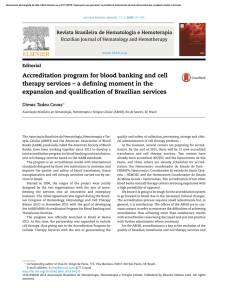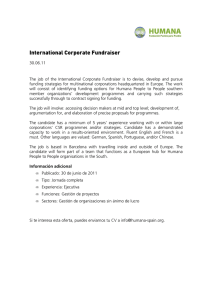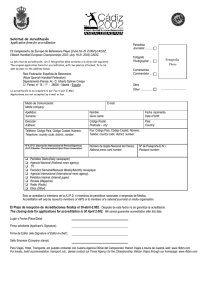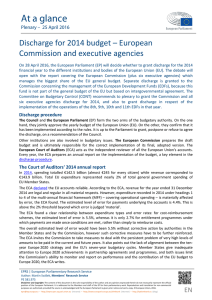Joint Programmes - Agence Erasmus+ France / Education Formation
Anuncio
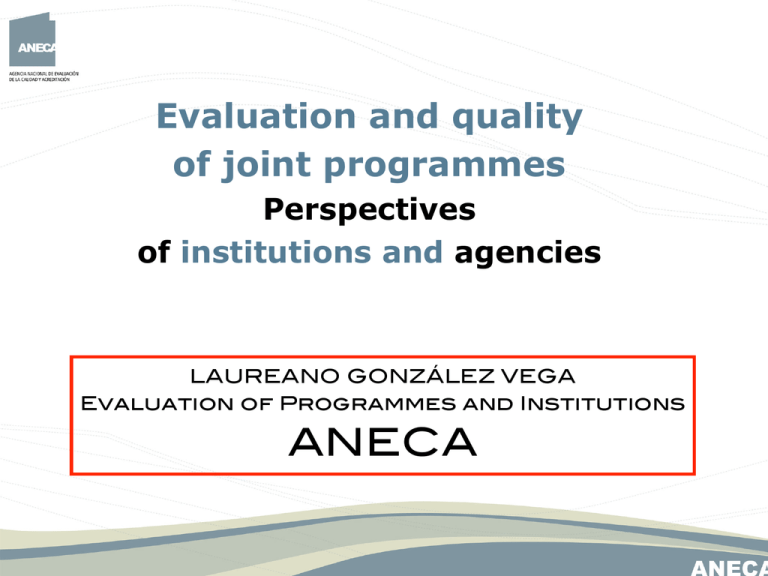
Evaluation and quality of joint programmes Perspectives of institutions and agencies LAUREANO GONZÁLEZ VEGA Evaluation of Programmes and Institutions ANECA Outline ECA Principles Accreditation Joint Programmes ECA: MULTRA The Spanish Case: Regulation & Evaluation CONCLUSIONS http://www.ecaconsortium.net http://www.ecaconsortium.net ECA: Principles http://www.ecaconsortium.net/main/projects/joqar ECA: Principles Principles for accreditation procedures regarding joint programmes (June 2007) The problem Joint programmes are programmes offered jointly by different higher education institutions irrespective of the degree (joint, multiple and double) awarded. Joint programmes could be subject to accreditation procedures by different accreditation organisations in each of the states where the joint programme is offered. These distinct accreditation jurisdictions imply the potential involvement of several accreditation organisations and therefore the execution of different accreditation procedures. ECA: Principles Principles for accreditation procedures regarding joint programmes (June 2007) ECA Position ECA members agree that the Code of Good Practice applies to all accreditation organisations including their procedures regarding joint programmes. The principles set out below could be an integral part of a mutual recognition agreement. This implies that accreditation decisions regarding joint programmes are/should be subject to the relevant mutual recognition of accreditation decisions agreements. To increase mutual trust and transparency, ECA members concur that accreditation procedures regarding joint programmes should take into account the following principles. ECA: Principles Principles for accreditation procedures regarding joint programmes (June 2007) 1. Information sharing and transparency To inform the other relevant accreditation organisation(s) about the request; The other relevant accreditation organisation(s) provide(s) information on: Whether the programme is part of, has already undergone or is undergoing a quality assurance and/or an accreditation procedure. Whether the relevant institutions can legally offer the joint programme (including the status of the degree involved). 2. The composition of the expert panel Particular emphasis on the inclusion of experts with relevant international experience and knowledge. http://www.ecaconsortium.net/main/projects/joqar ECA: Principles Principles for accreditation procedures regarding joint programmes (June 2007) 3. The assessment process Comprehensive information on the totality of the joint programme. The panel has to determine the site visit(s) requirements; Assessment on the totality of the joint programme. Assessment process should include at least one observer from another relevant accreditation organisation. 4. The accreditation decision Based on the assessment of the totality of the joint programme Communicated to the relevant accreditation organisation(s). http://www.ecaconsortium.net/main/projects/joqar ECA: Principles Principles for accreditation procedures regarding joint programmes (June 2007) A different version if programmes are accredited through institutional accreditation http://www.ecaconsortium.net/main/projects/joqar ECA: Principles Principles for accreditation procedures regarding joint programmes (June 2007) ECA Code of Good Practice Transparency & Trust ECA Bilateral Agreements http://www.ecaconsortium.net/main/projects/joqar ECA: MULTRA ECA: MULTRA Mutual Recognition of Accreditation Results regarding Joint Programmes The purpose of the MULTRA is to simplify the accreditation and recognition of joint programmes and degrees awarded and to provide an efficient way to expand mutual recognition to more European Higher Education Area countries. Started with JQAR project: Joint programmes: Quality Assurance and Recognition of degrees awarded ECA: MULTRA Mutual Recognition of Accreditation Results regarding Joint Programmes The signing accreditation organisations agree to apply the ECA principles for accreditation procedures regarding joint programmes; and confirm that within their competences they accept the results of the accreditation procedures of the other signing accreditation organisations when accrediting joint programmes; on the condition that the signing agencies continue to exchange information about their accreditation systems on a regular basis. Substantial changes of the accreditation systems should be communicated without delay. The signing accreditation organisations agree to give each other access to all relevant documents relating to the accreditation results. All documents must be treated confidentially until they are published. ECA: MULTRA Mutual Recognition of Accreditation Results regarding Joint Programmes MULTRA first signatories (December 10, 2010): ANECA (Spain) CTI (France) FHR and ÖAR (Austria) NVAO (The Netherlands and Flanders) PKA (Poland) ECA: MULTRA Mutual Recognition of Accreditation Results regarding Joint Programmes MULTRA admission procedure: ECA Management Group: “coordination point” Requirements: A valid bilateral recognition agreement, or A recent (≤5 years) external evaluation against the ESG criteria, the ECA Code of Good Practice or equivalent, and Two observers (from a MULTRA agency) carry out an on-site-observation: One observer should join a site-visit of a programme accreditation procedure, the other one should get evidence of the accreditation practice through discussions with the agency’s representatives. The observers should conclude their report with a recommendation. The MG formally checks the observation report and forwards the report including a decision proposal to the MULTRA members. Consensus of all signatory parties is needed for admission of new members. The Spanish Case THE SPANISH HIGHER EDUCATION SYSTEM ! RUCT SIIU A ACREDITA ! Accreditation Process in Spain 1. DESCRIPTION OF THE DEGREE 2. JUSTIFICATION 3. LEARNING OUTCOMES EX-ANTE ACCREDITATION CRITERIA 4. STUDENT ENTRY AND ADMISSION 5. PROGRAMME PLANNING 6. ACADEMIC STAFF 7. RESOURCES AND SERVICES 8. ANTICIPATED OUTCOMES 9. QUALITY ASSURANCE SYSTEM 10. AGENDA FOR IMPLEMENTING THE DEGREE ! Accreditation Process in Spain 1. DESCRIPTION OF THE DEGREE 2. JUSTIFICATION 3. LEARNING OUTCOMES EX-ANTE ACCREDITATION CRITERIA 4. STUDENT ENTRY AND ADMISSION 5. PROGRAMME PLANNING (& COORDINATION) 6. ACADEMIC STAFF 7. RESOURCES AND SERVICES 8. ANTICIPATED OUTCOMES 9. QUALITY ASSURANCE SYSTEM 10. AGENDA FOR IMPLEMENTING THE DEGREE ! Joint Programmes: Regulation REAL DECRETO 861/2010: Grado & Máster & Doctor Artículo 3 - Apartado 4 Las universidades podrán, mediante convenio con otras universidades nacionales o extranjeras, organizar enseñanzas conjuntas conducentes a la obtención de un único título oficial de Graduado o Graduada, Máster Universitario o Doctor o Doctora. Joint Programmes: Regulation REAL DECRETO 861/2010: Grado & Máster & Doctor Artículo 3 - Apartado 4 A efectos de lo anterior se entiende por título conjunto el correspondiente a un único plan de estudios oficial diseñado por dos o más universidades, españolas o extranjeras, que han suscrito el correspondiente convenio de colaboración y que han presentado una única solicitud de verificación, a efectos del procedimiento establecido en el artículo 25 de este real decreto. Dicha solicitud deberá estar suscrita por todas las universidades participantes que, asimismo, deberán designar a cuál de ellas corresponderá la representación en el citado procedimiento. Joint Programmes: Regulation REAL DECRETO 861/2010: Grado & Máster & Doctor Artículo 3 - Apartado 4 A tal fin, el plan de estudios deberá acompañarse del correspondiente convenio en el que se especificará, al menos, qué Universidad será responsable de la custodia de los expedientes de los estudiantes y de la expedición y registro del título así como el procedimiento de modificación o extinción de planes de estudios. En el supuesto de convenios con universidades extranjeras, se deberá acompañar al mismo certificación expedida por la autoridad competente o, en su caso, por la entidad acreditadora, del carácter oficial o acreditado de la universidad o universidades extranjeras de que se trate. En todo caso, la universidad española custodiará los expedientes de los títulos que expida. Joint Programmes: Evaluation PROGRAMME PLANNING Aspects to take into account: Joint Programmes versus Dual Programmes. Internal mobility for students and teaching staff and how to support this. Horizontal and vertical coordination: how modules are shared? who? where? ... A typical Joint Programme must fully exploit and take advantage of the synergies that bring the paticipating universities. Joint Programmes: Evaluation JOINT PROGRAMMES: ... & SPAIN The most complicated aspect here looks for the intersection, if any, among the regulation of the involved countries: ECTS for Bachelors and Masters different depending ... Different accreditation regulation: ex-ante, ex-post, ... Cases where different regulations are impossible to align. “Memorias de verificación” completely different depending in each country (the documentation issue). ........................................................................................... CONCLUSIONS Conclusions Joint Programmes are essential tools when talking about internationalization strategies (but not only EM !). MULTRA is a good initial step but difficulties are still (and will be) there. The design of a Joint Programme is not an easy task and requires a huge amount of work (the agrement ...). MERCI THANKS
